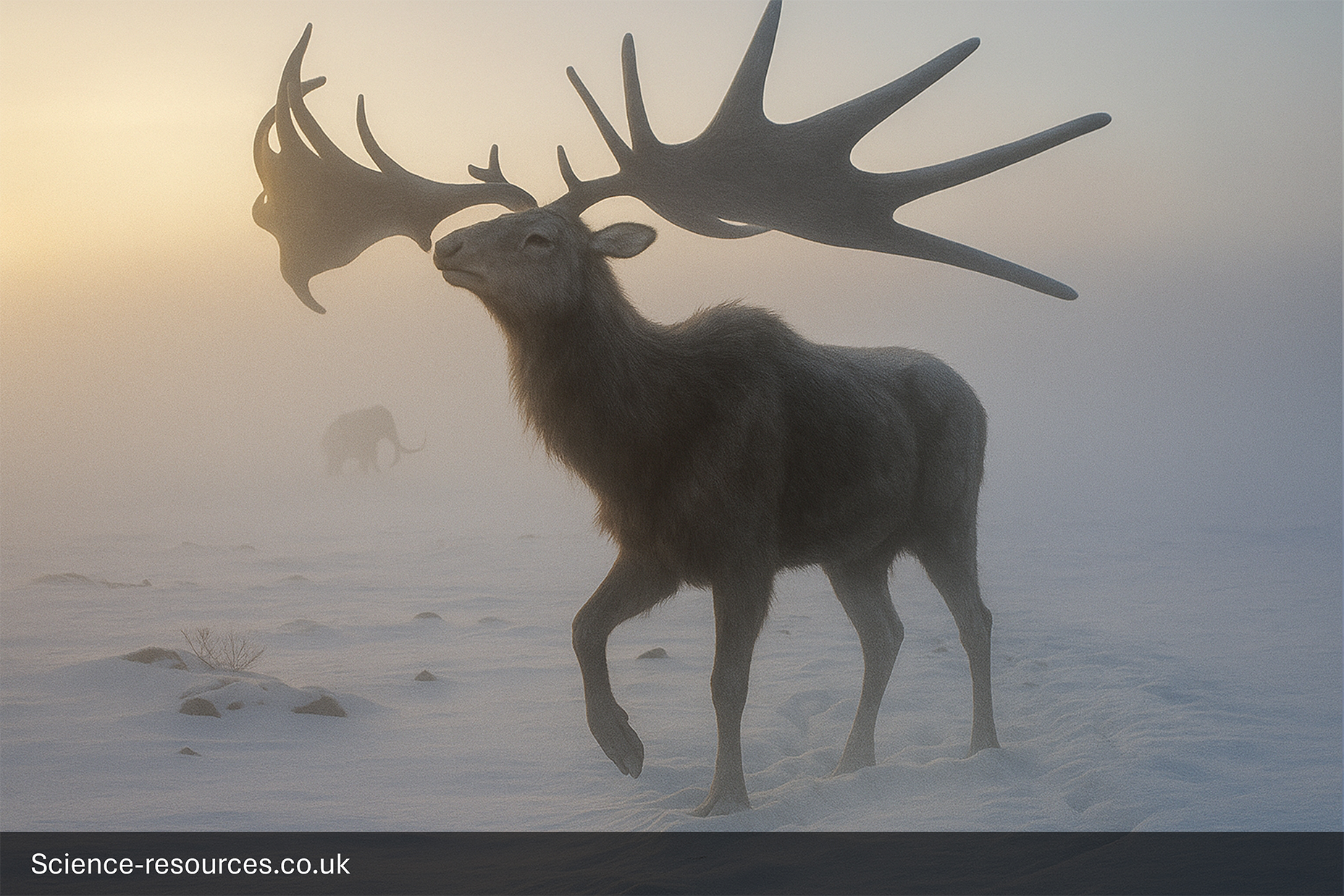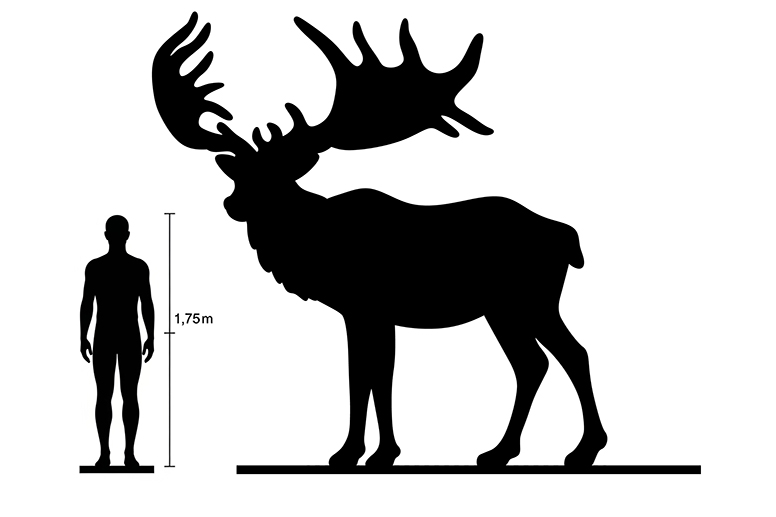Last updated: 4th August 2025
Extinct Animals: Megaloceros
Discover the giant deer with enormous antlers, that lived during the Ice Age.
Megaloceros (The Irish Elk)
 Megaloceros
Megaloceros
Generative AI Notification: Some elements of this image have been created or enhanced using AI technology. To find out how we create all our prehistoric animals, click here.
What is Megaloceros?
Megaloceros, sometimes called the "Irish Elk", was a giant prehistoric deer that lived alongside other Ice Age animals. These impressive creatures were especially famous for their enormous, wide antlers, which could be as long as two adult humans lying head to toe!
How big were Megaloceros?
Megaloceros were huge, standing up to 2 metres tall at the shoulders—about as tall as a tall adult! When you include their antlers, they could reach over 3.5 metres high. They weighed between 500 and 700 kilograms, making them one of the largest deer to ever walk the earth
What did Megaloceros eat?
Like modern deer, Megaloceros were herbivores—they only ate plants. Their diet included grasses, leaves, and shrubs found in open woodlands and meadows. Their large size meant they needed to eat lots of food every day to stay healthy and strong.
Megaloceros appearance
- Large bodies with long, strong legs for running and walking.
- Enormous, flat antlers that could span up to 3.5 metres wide.
- Thick fur to keep them warm during cold Ice Age winters.
- A face and body shape similar to today’s deer, but much, much bigger!
Where did Gomphotheres live?
Fossils show that Megaloceros lived across Eurasia, including Ireland, which is why they are sometimes called the "Irish Elk". They liked open forests and grassy plains, where there was plenty of room for their huge antlers and lots of plants to eat.
When did Megaloceros live?
Megaloceros first appeared about 400,000 years ago and survived until around 7,700 years ago, near the end of the last Ice Age. This means they lived at the same time as mammoths, mastodons, and even early humans!
Interesting facts
- Name means "Great Horn" in Greek, because of their massive antlers.
- Some antlers weighed as much as 40 kilograms—heavier than a large dog!
- Only the males had antlers, which they likely used to impress females and compete with other males.
- They are not actually elk—the name "Irish Elk" is a bit misleading. They are more closely related to today’s deer.
- Paintings of Megaloceros have been found in ancient caves, made by early humans who saw them in the wild.

Megaloceros Facts
Pronounced: MEG-ah-loh-SEH-ros
Name Means: "Great Horn" (from Greek roots)
Length: Up to 3 metres (nearly 10 feet) from nose to tail
Height: Up to 2 metres (about 6.5 feet) at the shoulder
Weight: Around 500 to 700 kilograms (1,100 to 1,540 pounds)
Diet: Herbivore (Grasses, leaves, shrubs, and other plants)
Time: From about 400,000 years ago until around 7,700 years ago (the end of the last Ice Age)
Fossils Found: Eurasia, including Ireland
Which family of animals did Megaloceros belong to?
Megaloceros belonged to the Cervidae family, which is the scientific group for all deer. This means they were related to animals like red deer, fallow deer, and reindeer. Although their size and antlers were much greater than most deer today, Megaloceros shared many features with their modern relatives, such as hooves and a plant-eating diet.
What other animals lived at the same time as Megaloceros?
They lived alongside wooly rhinos, mastodons, giant ground sloths (Megatherium), and early human populations, who often hunted them for food and resources.
Megaloceros FAQ
Q1: What is Megaloceros?
A1. Megaloceros was a giant extinct deer, also known as the Irish Elk, famous for its huge antlers!
Q2. Were Megaloceros dinosaurs?
A2. No, Megaloceros were mammals, not dinosaurs. They lived long after dinosaurs went extinct.
Q3. How big were Megaloceros?
A3. Megaloceros could grow up to 7 feet tall at the shoulders, and their antlers could span up to 12 feet wide!
Q4. What did Megaloceros eat?
A4. They were herbivores, which means they ate plants like grass, leaves, and shrubs.
Q5. Where did Megaloceros live?
A5. Megaloceros lived in Europe and parts of Asia, mostly in open woodlands and grassy plains.
Q6. Why are they called Irish Elk?
A6. Many Megaloceros fossils were found in Ireland, and their antlers reminded people of elk—even though they were more closely related to deer.
Q7. When did Megaloceros live?
A7. They lived during the Ice Age, from about 400,000 years ago until around 7,700 years ago.
Q8. Did humans ever see Megaloceros?
A8. Yes! Early humans lived at the same time and may have hunted them or drawn pictures of them in caves.
Q9. Why did Megaloceros go extinct?
A9. Scientists think they went extinct because of climate changes, habitat loss, and possibly human hunting.
Q10. How do scientists learn about Megaloceros?
A10. Scientists study fossils, especially their giant antlers and bones, to learn how they lived and what they looked like.
You may also be intrested in:
- Extinct Animals: A-Z
- Dinosaurs: A-Z
Tags: How big was Megaloceros, Megaloceros size, where did Megaloceros live, how tall was Megaloceros, what does Megaloceros mean, Megaloceros facts
Previous: Mastodon
Up next: Megatherium
© 2012 science-resources.co.uk. All rights reserved | Design by W3layouts
Extinct Animals: Megaloceros
Discover the giant deer with enormous antlers, that lived during the Ice Age.
Megaloceros (The Irish Elk)
 Megaloceros
Megaloceros
Generative AI Notification: Some elements of this image have been created or enhanced using AI technology. To find out how we create all our prehistoric animals, click here.
What is Megaloceros?
Megaloceros, sometimes called the "Irish Elk", was a giant prehistoric deer that lived alongside other Ice Age animals. These impressive creatures were especially famous for their enormous, wide antlers, which could be as long as two adult humans lying head to toe!
How big were Megaloceros?
Megaloceros were huge, standing up to 2 metres tall at the shoulders—about as tall as a tall adult! When you include their antlers, they could reach over 3.5 metres high. They weighed between 500 and 700 kilograms, making them one of the largest deer to ever walk the earth
What did Megaloceros eat?
Like modern deer, Megaloceros were herbivores—they only ate plants. Their diet included grasses, leaves, and shrubs found in open woodlands and meadows. Their large size meant they needed to eat lots of food every day to stay healthy and strong.
Megaloceros appearance
- Large bodies with long, strong legs for running and walking.
- Enormous, flat antlers that could span up to 3.5 metres wide.
- Thick fur to keep them warm during cold Ice Age winters.
- A face and body shape similar to today’s deer, but much, much bigger!
Where did Gomphotheres live?
Fossils show that Megaloceros lived across Eurasia, including Ireland, which is why they are sometimes called the "Irish Elk". They liked open forests and grassy plains, where there was plenty of room for their huge antlers and lots of plants to eat.
When did Megaloceros live?
Megaloceros first appeared about 400,000 years ago and survived until around 7,700 years ago, near the end of the last Ice Age. This means they lived at the same time as mammoths, mastodons, and even early humans!
Interesting facts
- Name means "Great Horn" in Greek, because of their massive antlers.
- Some antlers weighed as much as 40 kilograms—heavier than a large dog!
- Only the males had antlers, which they likely used to impress females and compete with other males.
- They are not actually elk—the name "Irish Elk" is a bit misleading. They are more closely related to today’s deer.
- Paintings of Megaloceros have been found in ancient caves, made by early humans who saw them in the wild.

Megaloceros Facts
Pronounced: MEG-ah-loh-SEH-ros
Name Means: "Great Horn" (from Greek roots)
Length: Up to 3 metres (nearly 10 feet) from nose to tail
Height: Up to 2 metres (about 6.5 feet) at the shoulder
Weight: Around 500 to 700 kilograms (1,100 to 1,540 pounds)
Diet: Herbivore (Grasses, leaves, shrubs, and other plants)
Time: From about 400,000 years ago until around 7,700 years ago (the end of the last Ice Age)
Fossils Found: Eurasia, including Ireland
Which family of animals did Megaloceros belong to?
Megaloceros belonged to the Cervidae family, which is the scientific group for all deer. This means they were related to animals like red deer, fallow deer, and reindeer. Although their size and antlers were much greater than most deer today, Megaloceros shared many features with their modern relatives, such as hooves and a plant-eating diet.
What other animals lived at the same time as Megaloceros?
They lived alongside wooly rhinos, mastodons, giant ground sloths (Megatherium), and early human populations, who often hunted them for food and resources.
Megaloceros FAQ
Q1: What is Megaloceros?
A1. Megaloceros was a giant extinct deer, also known as the Irish Elk, famous for its huge antlers!
Q2. Were Megaloceros dinosaurs?
A2. No, Megaloceros were mammals, not dinosaurs. They lived long after dinosaurs went extinct.
Q3. How big were Megaloceros?
A3. Megaloceros could grow up to 7 feet tall at the shoulders, and their antlers could span up to 12 feet wide!
Q4. What did Megaloceros eat?
A4. They were herbivores, which means they ate plants like grass, leaves, and shrubs.
Q5. Where did Megaloceros live?
A5. Megaloceros lived in Europe and parts of Asia, mostly in open woodlands and grassy plains.
Q6. Why are they called Irish Elk?
A6. Many Megaloceros fossils were found in Ireland, and their antlers reminded people of elk—even though they were more closely related to deer.
Q7. When did Megaloceros live?
A7. They lived during the Ice Age, from about 400,000 years ago until around 7,700 years ago.
Q8. Did humans ever see Megaloceros?
A8. Yes! Early humans lived at the same time and may have hunted them or drawn pictures of them in caves.
Q9. Why did Megaloceros go extinct?
A9. Scientists think they went extinct because of climate changes, habitat loss, and possibly human hunting.
Q10. How do scientists learn about Megaloceros?
A10. Scientists study fossils, especially their giant antlers and bones, to learn how they lived and what they looked like.
Tags: How big was Megaloceros, Megaloceros size, where did Megaloceros live, how tall was Megaloceros, what does Megaloceros mean, Megaloceros facts
Previous: Mastodon
Up next: Megatherium
© 2012 science-resources.co.uk. All rights reserved | Design by W3layouts